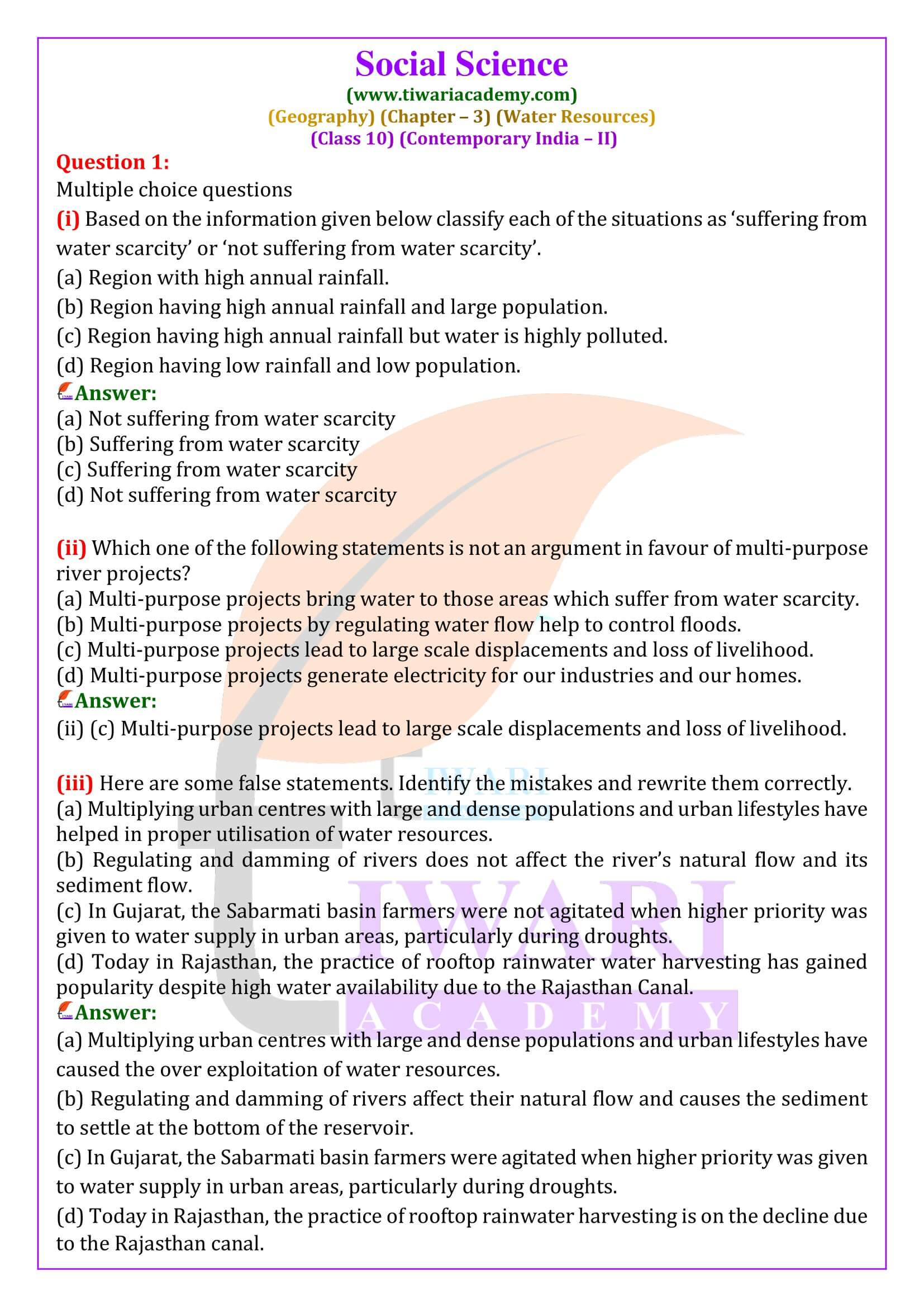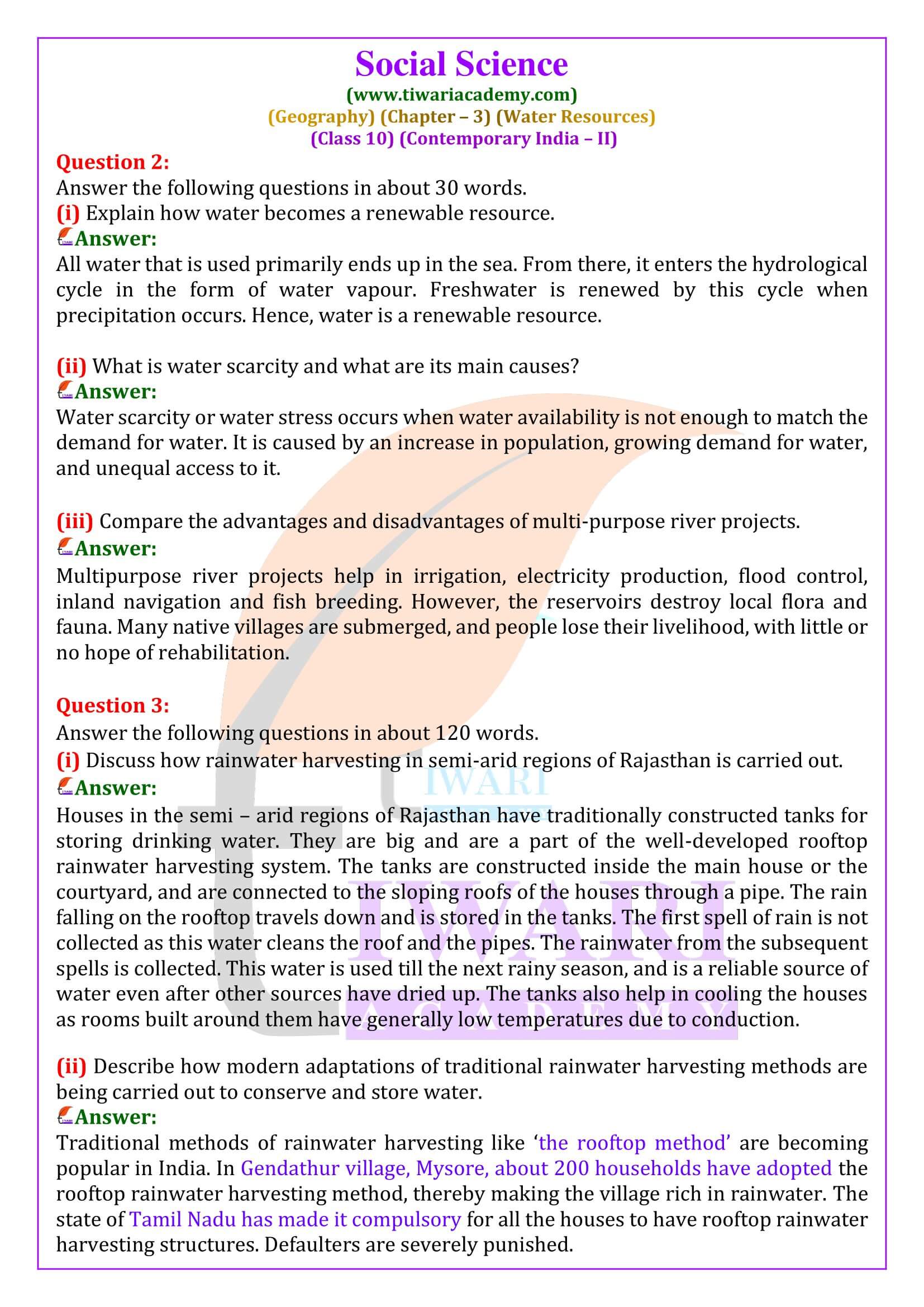NCERT Solutions for Class 10 Geography Chapter 3 Water Resources in English and Hindi Medium updated for new academic session 2025-26 based on new NCERT Books and following the new CBSE Syllabus for 2025-26. Important questions, Important terms related to the chapter is also added with NCERT Solutions. The theoretical aspect of chapter ‘Water Resources’ to be assessed in the Periodic Tests only and will not be evaluated in Board Examination. However, the map items of this chapter as given in the Map List will be evaluated in Board Examination.
NCERT Solutions for Class 10 Geography Chapter 3 in PDF
| Class: | 10 |
| Subject: | Social Science – Geography |
| Chapter 3: | Water Resources |
| Academic Session: | 2025-26 |
Class 10 Geography Chapter 3 Water Resources
NCERT Solutions for Class 10 Geography Chapter 3 in PDF format updated for new academic session 2025-26. Download Apps and digital contents for offline use based on latest CBSE Syllabus. If you have any doubt, please visit to discussion forum and ask your queries regarding to NIOS or CBSE Board.
Exatra Questions Class 10 Geography Chapter 3
How the Industrialisation and urbanization are responsible for the water scarcity?
(i) Rapid industrialisation after the independence.
(ii) Due to ever-increasing number of industries excess use of fresh water.
(iii) Multiplying urban centres with large and dense population and urban lifestyles have added to water and energy requirements.
(iv) Overexploitation of water resources in cities as well as in villages.
What is Rain Water Harvesting? Write any two methods of Rain Water Harvesting popular in different regions of India?
(i) A technique in which rain water is filled in empty places, tanks in houses, abandoned dugwell etc. Later it is used.
(ii) In hill and mountainous regions, people built diversion channels like ‘guls’ and ‘kuls’ for irrigation.
(iii) ‘Rooftop rain water harvesting’ was commonly practiced to store drinking water, particularly in Rajasthan.
(iv) In the flood plains of Bengal, people developed inundation channels to irrigate their fields.
(v) Rain fed storage structures like the ‘Khadins’ and ‘Johads’ in arid and semi-arid regions.
How does an abandoned dug well can be re-filled by the rain water?
(i) Roof top rain water is collected using a PVC pipe
(ii) Filtered using sand and bricks
(iii) Underground pipe takes water to sumps for immediate usage
(iv) Excess water from the sump is taken to the well.
(v) Water from the well recharges the underground
(vi) Later take water from the well.
Why does the water need to be conserve and managed despite being a renewable resource?
(i) There is only 2.5% fresh water in the world.
(ii) Overexploitation of water resources.
(iii) Growing population, greater demand and unequal access.
(iv) Increasing Urbanization.
(v) Due to Industrialisation.
What is multipurpose river valley project? State different purposes of these projects?
Building dams on a river and achieving many purposes is called Multi-purpose projects. Some of these are as follows:
(i) Irrigation
(ii) Electricity generation
(iii) Water supply for domestic and industrial uses
(iv) Inland navigation and tourism
(v) Flood control
(vi) Fish breeding.
Why the scarcity of water is increasing in our country day by day? Enlist the reasons behind it?
(i) India is a country of Monsoon climate. Sometime due to the failure of Monsoon the scarcity of water Increases.
(ii) The rapid growth in the demand of irrigation water.
(iii) Due to the industrial activities downfall of underground water.
(iv) Growing pressure on the water resources due to the pace of urbanization.
(v) To meet the needs of the growing population.
1. 96.5% of the total volume of world’s water is estimated to exists as oceans and only 2.5% as freshwater.
2. River Basin-Total irrigated area by the main river and its tributaries.
3. “Narmada Bachao Andolan”{Save Narmada Movement}-A movement against the Sardar Sarovar Dam being built across the Narmada river.
4. Underground Water-The water which is collected in the layers and rock pores below the soil.
5. Rain water harvesting-Collecting the rain water in dug wells and reuse of it.
6. Waterfall-In the middle of the river valley fall of a stream from a height.
7. Dam-A dam is a barrier across flowing water that obstructs, directs or retards the flow, often creating a reservoir, lake or impoundment.
8. Multinational companies(MNCS)-Those companies whose industrial organisations work more than in a single nation and they invest capital in many countries to earn maximum profits.
9. Multi-purpose Projects-Many uses of the impounded water are integrated by making a dam.
10. Bamboo Drip Irrigation System-Tapping stream and spring water for irrigation by using bamboo pipes.
One Mark Questions with Answers
1. How much water is there in the world out of total volume for the use of humans?
2. Name the state and the river on which the Tehri Dam Project situated?
3. What was the main purpose of starting multipurpose projects after the independence of India?
4. What are Khadins’ and ‘Johads’?
5. By which name the roof top water harvesting is called in Rajasthan?
Answer of 1 Mark Questions
1. 2.5%
2. On Bhagirathi river in Uttrakhand.
3. (i) Development of Agriculture and the village economy. (ii) Rapid industrialisation (iii) Growth of the urban economy.
4. Rain fed storage structures to collect the water in arid and semi-arid regions.
5. Tanka
Important Questions on Class 10 Geography Chapter 3
Explain how water becomes a renewable resource.
All water that is used primarily ends up in the sea. From there, it enters the hydrological cycle in the form of water vapour. Freshwater is renewed by this cycle when precipitation occurs. Hence, water is a renewable resource.
What is water scarcity and what are its main causes?
Water scarcity or water stress occurs when water availability is not enough to match the demand for water. It is caused by an increase in population, growing demand for water, and unequal access to it.
Compare the advantages and disadvantages of multi-purpose river projects.
Multipurpose river projects help in irrigation, electricity production, flood control, inland navigation and fish breeding. However, the reservoirs destroy local flora and fauna. Many native villages are submerged, and people lose their livelihood, with little or no hope of rehabilitation.
Discuss how rainwater harvesting in semi-arid regions of Rajasthan is carried out.
Houses in the semi – arid regions of Rajasthan have traditionally constructed tanks for storing drinking water. They are big and are a part of the well-developed rooftop rainwater harvesting system. The tanks are constructed inside the main house or the courtyard, and are connected to the sloping roofs of the houses through a pipe. The rain falling on the rooftop travels down and is stored in the tanks. The first spell of rain is not collected as this water cleans the roof and the pipes. The rainwater from the subsequent spells is collected. This water is used till the next rainy season, and is a reliable source of water even after other sources have dried up. The tanks also help in cooling the houses as rooms built around them have generally low temperatures due to conduction.
Describe how modern adaptations of traditional rainwater harvesting methods are being carried out to conserve and store water.
Traditional methods of rainwater harvesting like ‘the rooftop method’ are becoming popular in India. In Gendathur village, Mysore, about 200 households have adopted the rooftop rainwater harvesting method, thereby making the village rich in rainwater. The state of Tamil Nadu has made it compulsory for all the houses to have rooftop rainwater harvesting structures. Defaulters are severely punished.





